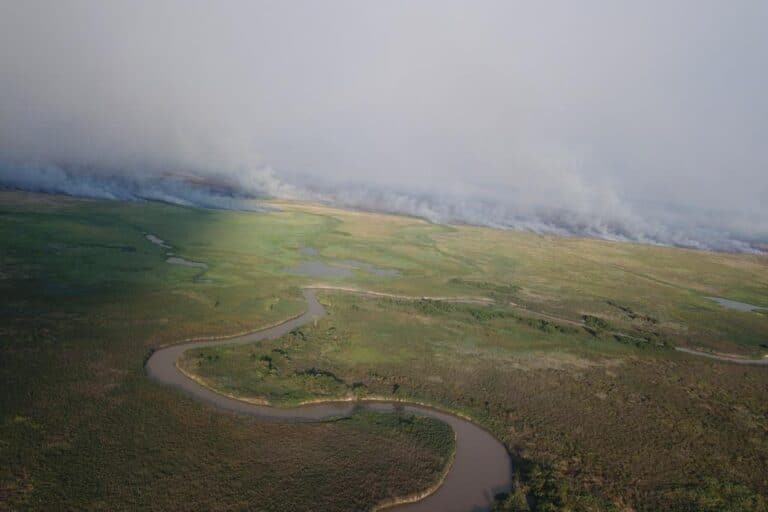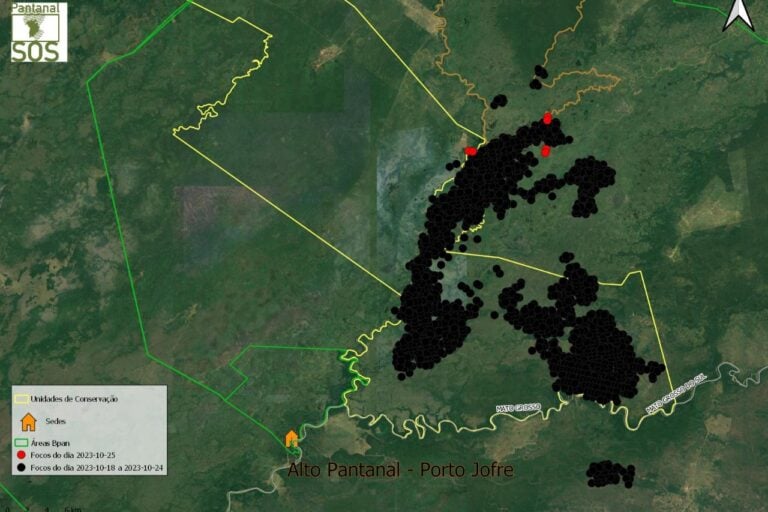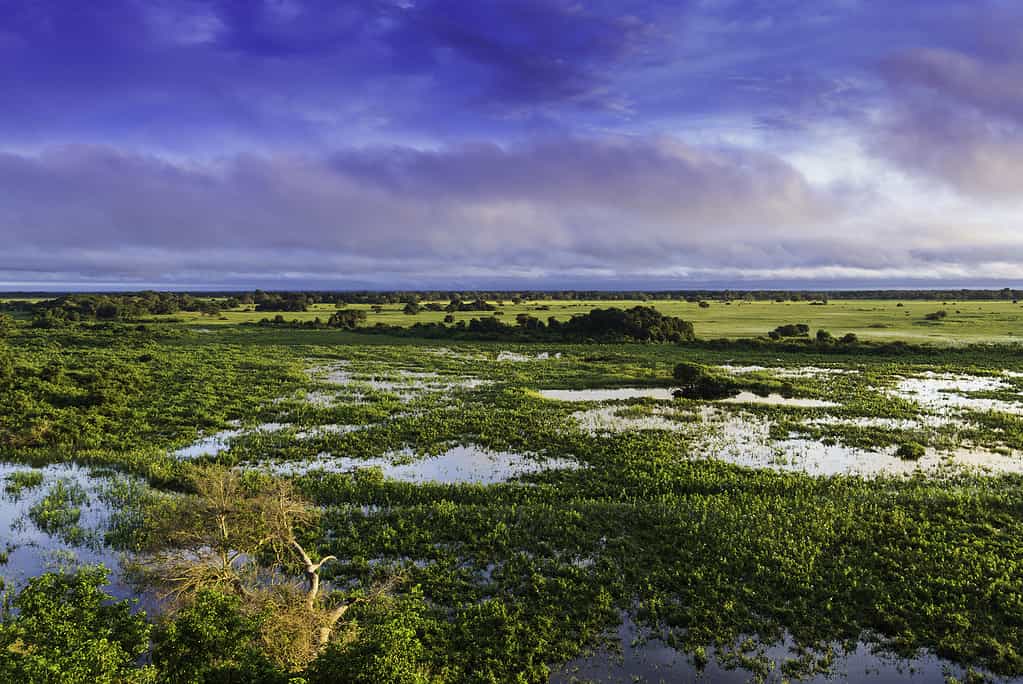
After a scorching heat wave fueled a month of wildfires blazing across a wild jaguar haven, the rains of Oct. 24 brought welcome relief to Brazil’s northern Pantanal wetlands. Now, environmentalists are assessing the damage and bracing for further fire risks amid a forecast for more hot weather in one of the biome’s most important protected areas.
The fires began Sept. 23 inside a cattle ranch after lightning struck a densely forested area. The fire started small and was expected to burn itself out. But wind gusts of up to 40 kilometers per hour (25 miles per hour) fanned the flames over to the neighboring Encontro das Águas State Park, a 108,000-hectare (nearly 267,000-acre) wildlife hotspot with the highest concentration of jaguars in the world. Data from the Federal University of Rio de Janeiro’s satellite system, LASA, showed that in October, more than a fifth of the park was burned, an area the size of nearly 30,000 soccer pitches.

Rescue teams have been scanning the charred remains of the park, looking for injured animals. The region’s flooded landscape and hostile terrain makes assessing the damage to wildlife populations difficult, but “for sure a lot of animals died,” Gustavo Figueirôa, a conservationist and director of the NGO SOS Pantanal, told Mongabay. Experts from the region say most of the animals killed were reptiles and amphibians unable to escape the flames. The jaguar population appears to be unscathed as the big cats were able to outrun the blazes.
“The jaguars are the ones that have made it to the rivers, and they’re fine,” Abigail Martin, founder of the Jaguar Identification Project, told Mongabay. “They’re hunting there. We saw a bunch of cubs the other day.”

Although the recent downpour of rain tamed the roaring wildfire into small patches of controllable flames, experts warn that warm, dry days ahead pose an immediate serious threat to the park. “The Pantanal is a wetland, which has a lot of biomasses accumulated over the years. When it starts to burn, this fire goes deep in the soil,” Fernando Tortato, Brazil project coordinator for Panthera, the global wildcat conservation organization, told Mongabay. These smoldering embers are ticking time bombs and can reignite once conditions become dry again.
“If the temperature increases, these [fire] points can light up and burn again,” Mayara Vicenzi, a veterinarian at the animal rescue group GRAD, which is currently working in the region, told Mongabay. This could spell disaster for the park and its wildlife. “What’s important is that this fire threshold is very close to the jaguar hotspot — it’s only about 3.5 kilometers [2 miles] away, and on hot days the fire travels 500 meters [1,640 feet] a night, more during the day,” Vicenzi added.
Firefighters deployed by the state of Mato Grosso have been battling the blazes since October, according to an official statement, with 40 military personnel distributed at strategic points along the Canabu, Cuiabá and São Lourenço rivers near the park. The general commander of the state’s military fire department, Alessandro Borges, said the team is carrying out waterbombing by plane to dampen the flames’ intensity and using boats to access the wildfires while monitoring the situation via satellites. By Oct. 19, they had the flames contained within a flooded area, the statement said.

Locals, however, say the responses to the wildfires were initially ineffective and took too long. Those on the ground told Mongabay that disputes over whether state or federal authorities should be responsible hindered the response, which was then further delayed by federal teams not having authorization to enter impacted areas to put out the flames.
The Mato Grosso state fire department told Mongabay that its teams “were sent shortly after the fire was detected” on Oct. 2. It confirmed that authorities had agreed that only state firefighters could operate in Encontro das Águas State Park, while federal firefighters, working under IBAMA, the national environmental protection agency, would respond to federally administered protected areas in the Pantanal.
The federal firefighting team, known as PREVFOGO, did not respond to Mongabay’s request for comment.
A fiery new normal
Natural wildfires are a common natural phenomenon in the Pantanal, a biome ruled by the extremes of the annual wet and dry seasons. “The fire is part of the ecological system of the Pantanal and some species are very well adapted to it,” Tortato said. But environmentalists point to unusual weather patterns in the wetlands, sparking unprecedented and atypical fires. “The problem is that we have more and more fires every year,” Tortato said.
Experts say these irregular fires are becoming increasingly normal in the Pantanal, serving as a striking example of real-life climate change impacts. “The tendency is for it to get hotter and drier,” Figueirôa said. “The park is suffering a lot from recurring fires that occurred not long ago.”
Previously, fires would occur less frequently, giving affected areas time to recover, thanks to what Figueirôa called the Pantanal’s “window of resilience.”
“The fauna and flora are used to fires, but at a lower intensity and less frequency,” he said. “With the current frequency of fires and this increased intensity, you reduce this resilience.”

The Pantanal has been hit by a series of severe fires in recent years, with 2020 considered the worst in the wetland’s recorded history. An estimated 17 million animals were killed in the flames, although other estimates go much higher. More than 85% of Encontro das Águas State Park was burned that year, and in total, approximately a third of the Pantanal was hit by fire. Climate change is expected to increase the frequency and intensity of wildfires across the world, with the Pantanal forecast to experience a 30% decrease in rainfall between 2070 and 2100. “It’s important to reinforce prevention work. We will have to adapt,” Figueirôa said.
Prevention measures will require a coordinated approach from both state and federal authorities, Tortato said. “When the fires start, it’s hard to control. But we need to think before this happens, we need to prevent these threats,” he said.
The Mato Grosso government has allocated much more this year in fighting fires and illegal deforestation, allocating 77.4 million reais ($15.5 million), a 29% increase from 2022. However, developing a robust prevention plan will require more funding and planning, experts say. “This will be possible only with more investment in people, in personnel, in management, and in equipment. That’s the gap that I think will be crucial for the Pantanal,” Tortato said, adding that prevention is also more cost-effective: “It’s definitely cheaper than firefighting later.”
The centuries-old practice of prescribed burning can also help reduce the intensity of fires and is “an essential tool in integrated fire management,” Figueirôa said. With authorization from the state, ranchers are permitted to burn vegetation matter on native pastures, which, when done correctly, helps reduce the amount of fuel that allows fires to advance quickly.
For now, experts remain on guard in anticipation of the worst-case scenario of the fires returning under the current hot weather. “Now that [the flames] have died down, it’s not time to relax,” Figueirôa said. “On the contrary, it’s time to be firm and carry out very strict monitoring to ensure that the fire doesn’t return.”
This article was originally published on Mongabay (CC BY 4.0).






